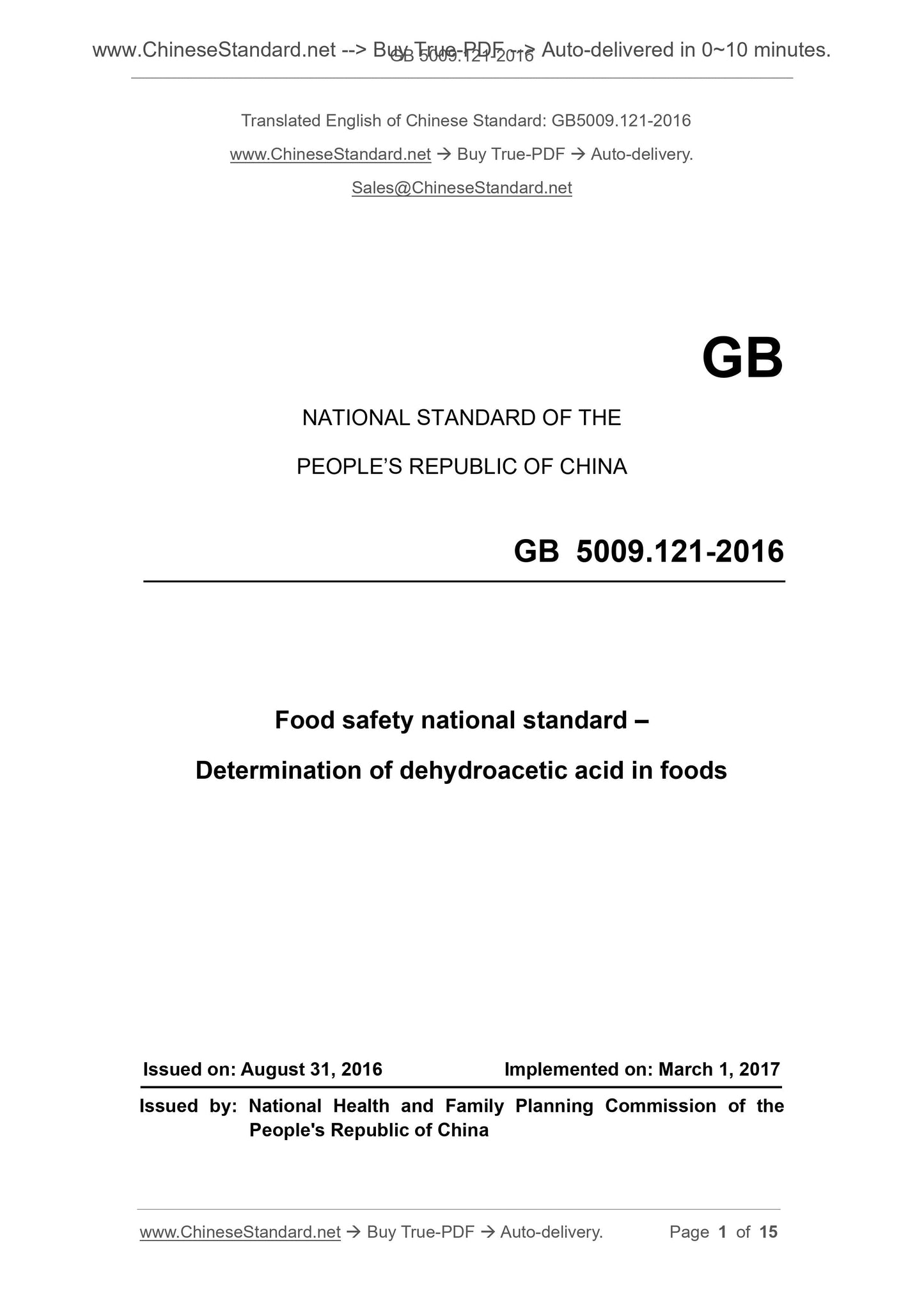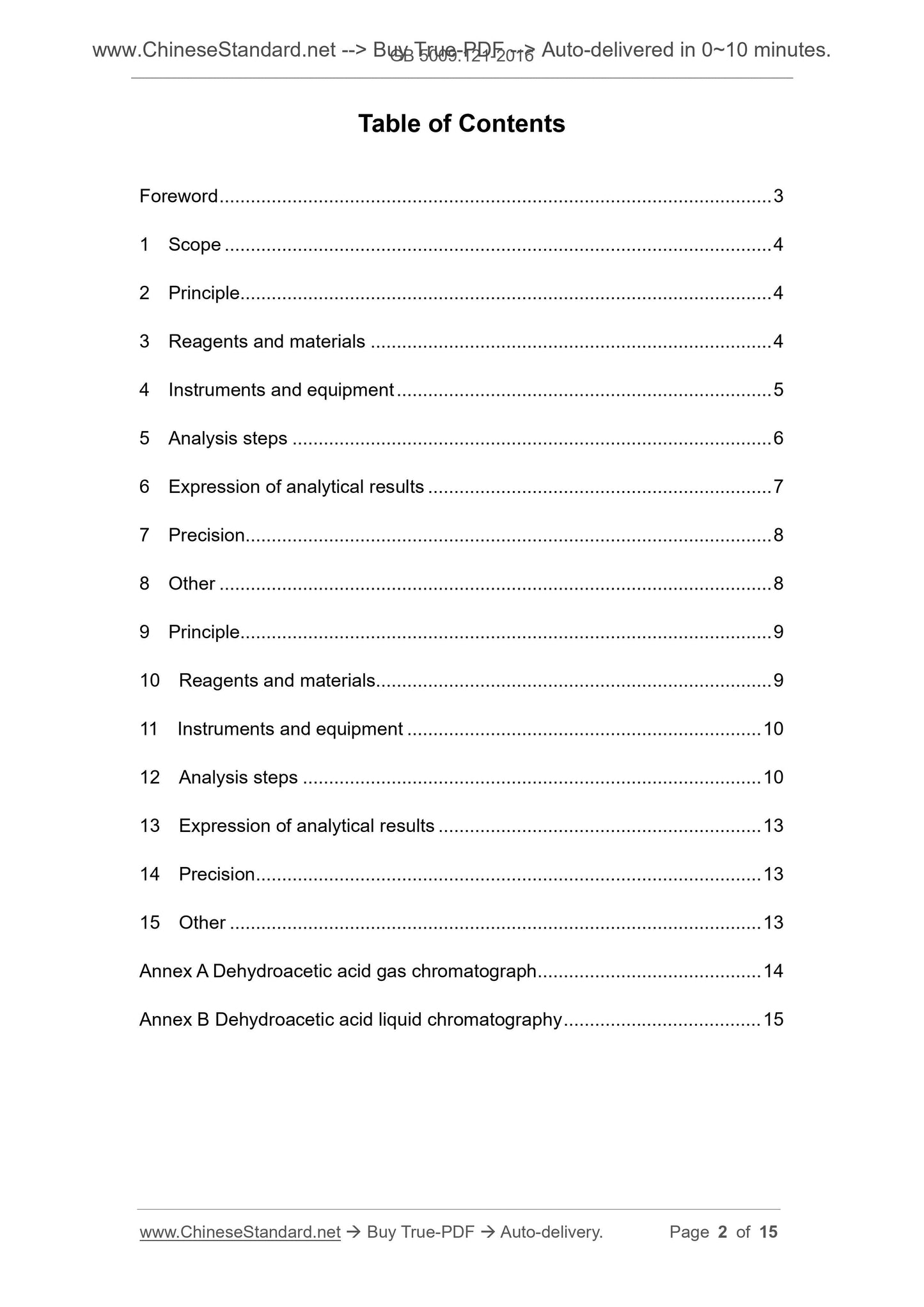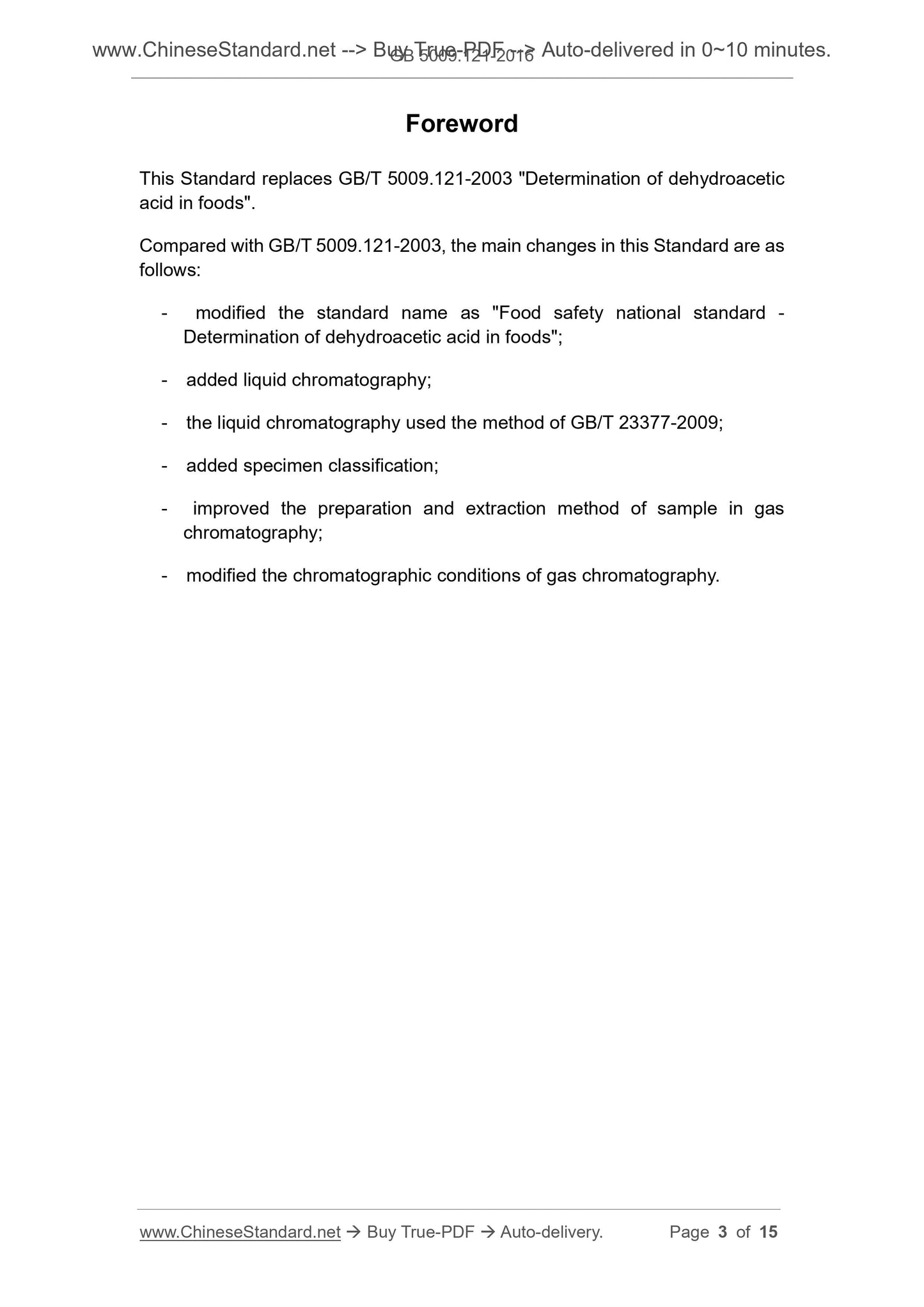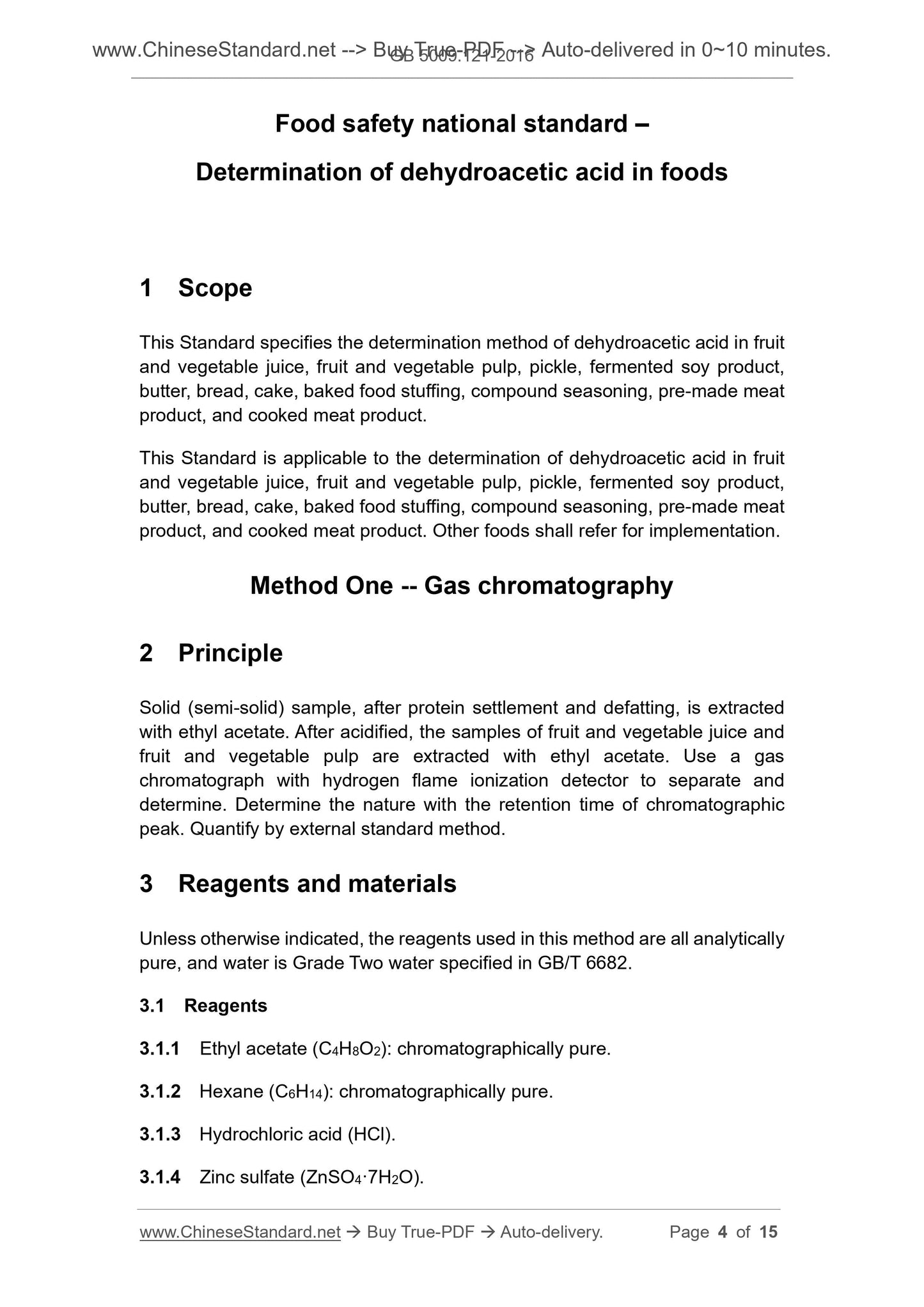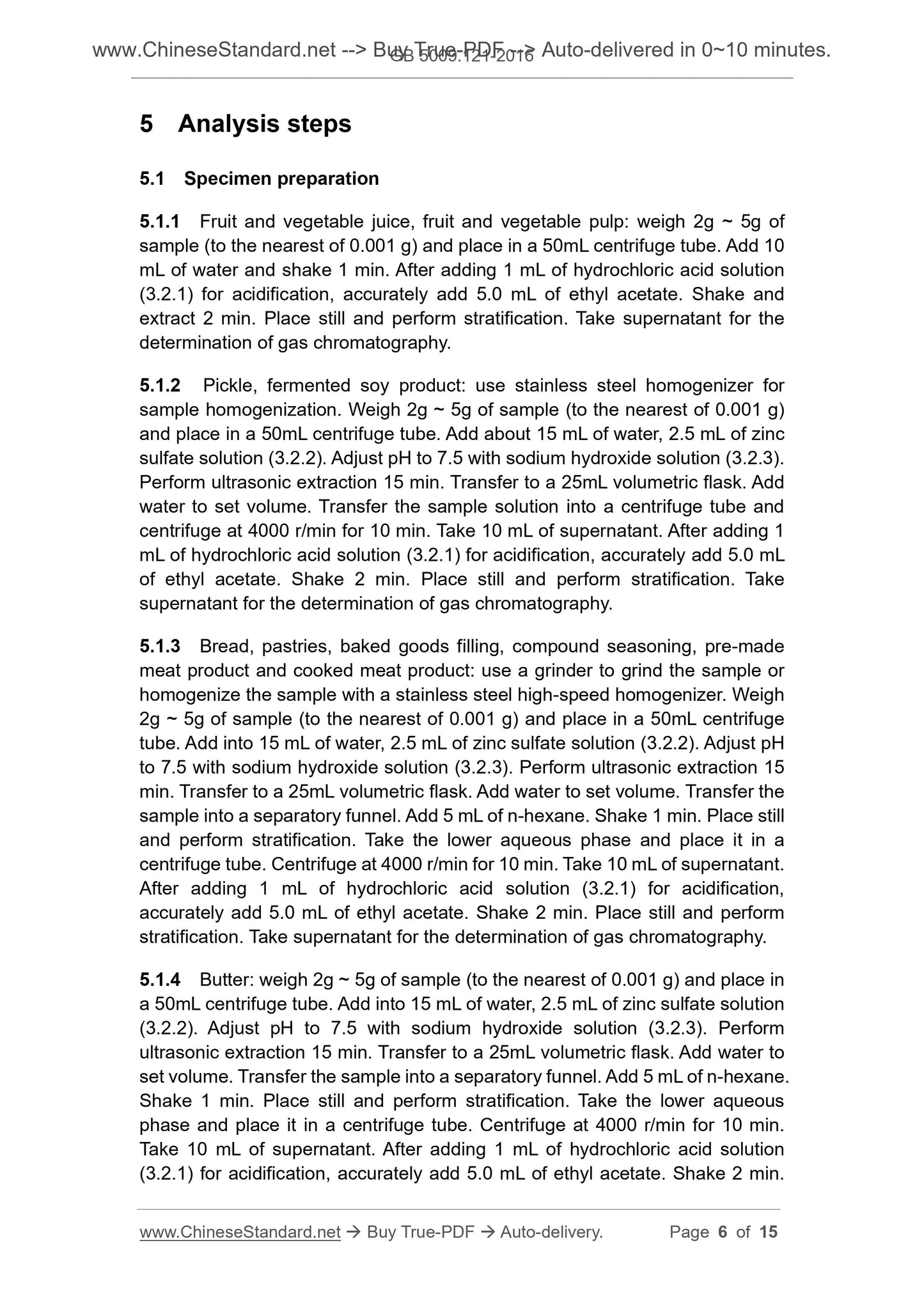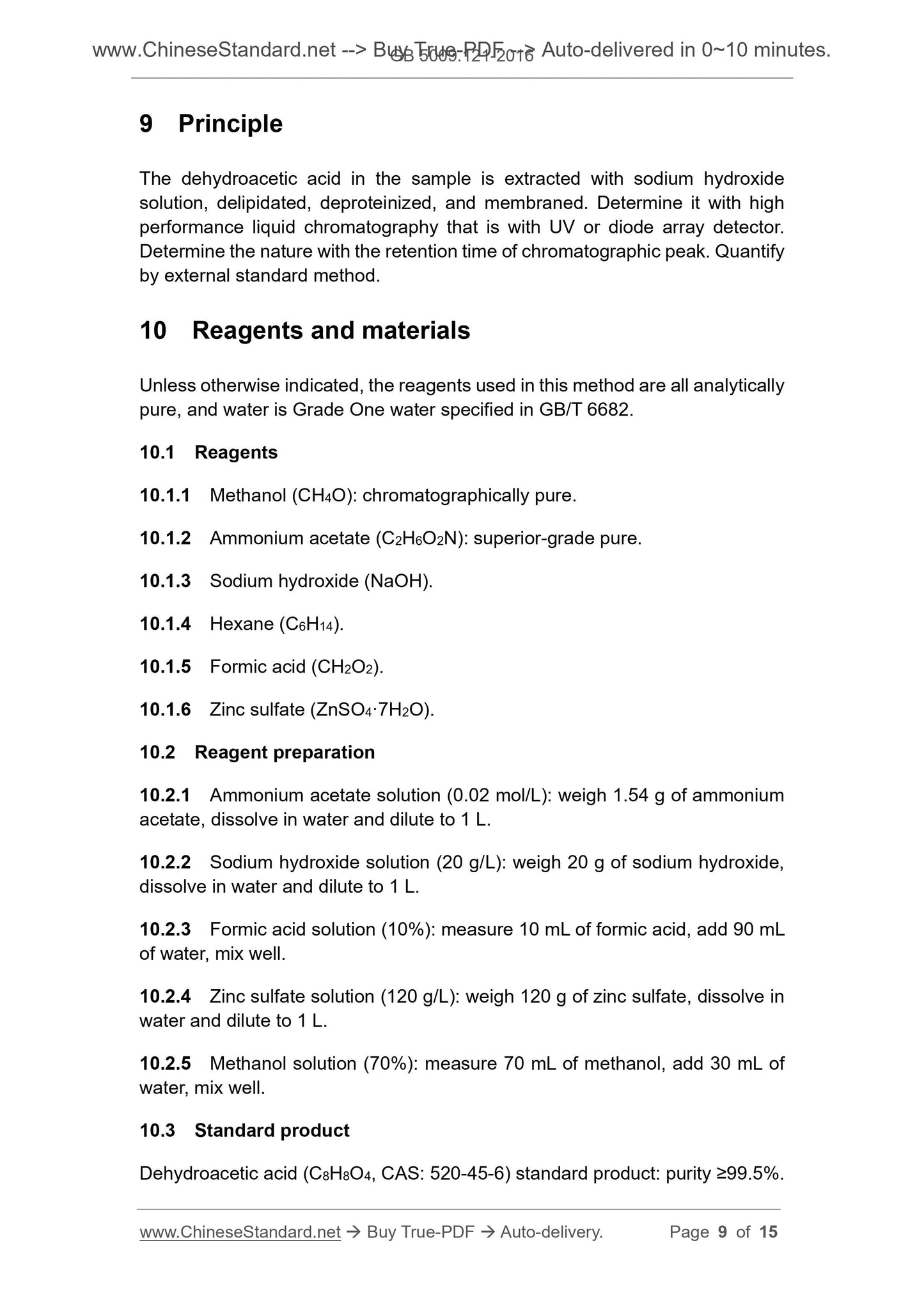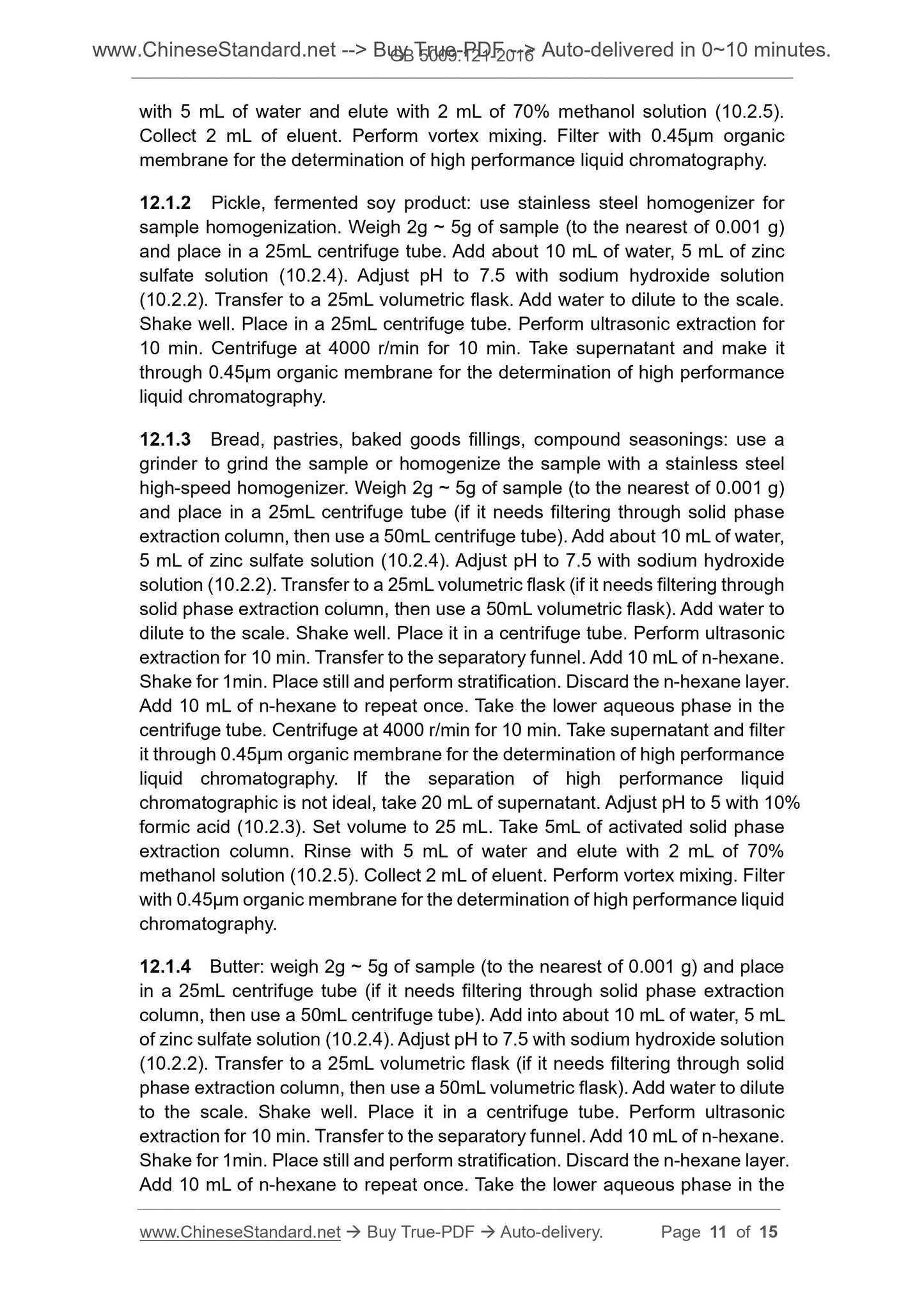1
/
of
7
www.ChineseStandard.us -- Field Test Asia Pte. Ltd.
GB 5009.121-2016 English PDF
GB 5009.121-2016 English PDF
Regular price
$85.00
Regular price
Sale price
$85.00
Unit price
/
per
Shipping calculated at checkout.
Couldn't load pickup availability
GB 5009.121-2016: Food safety national standard - Determination of dehydroacetic acid in foods
Delivery: 9 seconds. Download (& Email) true-PDF + Invoice.
Get Quotation: Click GB 5009.121-2016 (Self-service in 1-minute)
Historical versions (Master-website): GB 5009.121-2016
Preview True-PDF (Reload/Scroll-down if blank)
GB 5009.121-2016
GB
NATIONAL STANDARD OF THE
PEOPLE’S REPUBLIC OF CHINA
Food safety national standard –
Determination of dehydroacetic acid in foods
ISSUED ON. AUGUST 31, 2016
IMPLEMENTED ON. MARCH 1, 2017
Issued by. National Health and Family Planning Commission of the
People's Republic of China
Table of Contents
Foreword . 3
1 Scope .. 4
2 Principle.. 4
3 Reagents and materials .. 4
4 Instruments and equipment . 5
5 Analysis steps . 6
6 Expression of analytical results . 7
7 Precision. 8
8 Other . 8
9 Principle.. 9
10 Reagents and materials. 9
11 Instruments and equipment .. 10
12 Analysis steps .. 10
13 Expression of analytical results .. 13
14 Precision .. 13
15 Other .. 13
Annex A Dehydroacetic acid gas chromatograph . 14
Annex B Dehydroacetic acid liquid chromatography . 15
Foreword
This Standard replaces GB/T 5009.121-2003 "Determination of dehydroacetic
acid in foods".
Compared with GB/T 5009.121-2003, the main changes in this Standard are as
follows.
- modified the standard name as "Food safety national standard -
Determination of dehydroacetic acid in foods";
- added liquid chromatography;
- the liquid chromatography used the method of GB/T 23377-2009;
- added specimen classification;
- improved the preparation and extraction method of sample in gas
chromatography;
- modified the chromatographic conditions of gas chromatography.
Food safety national standard –
Determination of dehydroacetic acid in foods
1 Scope
This Standard specifies the determination method of dehydroacetic acid in fruit
and vegetable juice, fruit and vegetable pulp, pickle, fermented soy product,
butter, bread, cake, baked food stuffing, compound seasoning, pre-made meat
product, and cooked meat product.
This Standard is applicable to the determination of dehydroacetic acid in fruit
and vegetable juice, fruit and vegetable pulp, pickle, fermented soy product,
butter, bread, cake, baked food stuffing, compound seasoning, pre-made meat
product, and cooked meat product. Other foods shall refer for implementation.
Method One -- Gas chromatography
2 Principle
Solid (semi-solid) sample, after protein settlement and defatting, is extracted
with ethyl acetate. After acidified, the samples of fruit and vegetable juice and
fruit and vegetable pulp are extracted with ethyl acetate. Use a gas
chromatograph with hydrogen flame ionization detector to separate and
determine. Determine the nature with the retention time of chromatographic
peak. Quantify by external standard method.
3 Reagents and materials
Unless otherwise indicated, the reagents used in this method are all analytically
pure, and water is Grade Two water specified in GB/T 6682.
3.1 Reagents
3.1.1 Ethyl acetate (C4H8O2). chromatographically pure.
3.1.2 Hexane (C6H14). chromatographically pure.
3.1.3 Hydrochloric acid (HCl).
3.1.4 Zinc sulfate (ZnSO4·7H2O).
5 Analysis steps
5.1 Specimen preparation
5.1.1 Fruit and vegetable juice, fruit and vegetable pulp. weigh 2g ~ 5g of
sample (to the nearest of 0.001 g) and place in a 50mL centrifuge tube. Add 10
mL of water and shake 1 min. After adding 1 mL of hydrochloric acid solution
(3.2.1) for acidification, accurately add 5.0 mL of ethyl acetate. Shake and
extract 2 min. Place still and perform stratification. Take supernatant for the
determination of gas chromatography.
5.1.2 Pickle, fermented soy product. use stainless steel homogenizer for
sample homogenization. Weigh 2g ~ 5g of sample (to the nearest of 0.001 g)
and place in a 50mL centrifuge tube. Add about 15 mL of water, 2.5 mL of zinc
sulfate solution (3.2.2). Adjust pH to 7.5 with sodium hydroxide solution (3.2.3).
Perform ultrasonic extraction 15 min. Transfer to a 25mL volumetric flask. Add
water to set volume. Transfer the sample solution into a centrifuge tube and
centrifuge at 4000 r/min for 10 min. Take 10 mL of supernatant. After adding 1
mL of hydrochloric acid solution (3.2.1) for acidification, accurately add 5.0 mL
of ethyl acetate. Shake 2 min. Place still and perform stratification. Take
supernatant for the determination of gas chromatography.
5.1.3 Bread, pastries, baked goods filling, compound seasoning, pre-made
meat product and cooked meat product. use a grinder to grind the sample or
homogenize the sample with a stainless steel high-speed homogenizer. Weigh
2g ~ 5g of sample (to the nearest of 0.001 g) and place in a 50mL centrifuge
tube. Add into 15 mL of water, 2.5 mL of zinc sulfate solution (3.2.2). Adjust pH
to 7.5 with sodium hydroxide solution (3.2.3). Perform ultrasonic extraction 15
min. Transfer to a 25mL volumetric flask. Add water to set volume. Transfer the
sample into a separatory funnel. Add 5 mL of n-hexane. Shake 1 min. Place still
and perform stratification. Take the lower aqueous phase and place it in a
centrifuge tube. Centrifuge at 4000 r/min for 10 min. Take 10 mL of supernatant.
After adding 1 mL of hydrochloric acid solution (3.2.1) for acidification,
accurately add 5.0 mL of ethyl acetate. Shake 2 min. Place still and perform
stratification. Take supernatant for the determination of gas chromatography.
5.1.4 Butter. weigh 2g ~ 5g of sample (to the nearest of 0.001 g) and place in
a 50mL centrifuge tube. Add into 15 mL of water, 2.5 mL of zinc sulfate solution
(3.2.2). Adjust pH to 7.5 with sodium hydroxide solution (3.2.3). Perform
ultrasonic extraction 15 min. Transfer to a 25mL volumetric flask. Add water to
set volume. Transfer the sample into a separatory funnel. Add 5 mL of n-hexane.
Shake 1 min. Place still and perform stratification. Take the lower aqueous
phase and place it in a centrifuge tube. Centrifuge at 4000 r/min for 10 min.
Take 10 mL of supernatant. After adding 1 mL of hydrochloric acid solution
(3.2.1) for acidification, accurately add 5.0 mL of ethyl acetate. Shake 2 min.
9 Principle
The dehydroacetic acid in the sample is extracted with sodium hydroxide
solution, delipidated, deproteinized, and membraned. Determine it with high
performance liquid chromatography that is with UV or diode array detector.
Determine the nature with the retention time of chromatographic peak. Quantify
by external standard method.
10 Reagents and materials
Unless otherwise indicated, the reagents used in this method are all analytically
pure, and water is Grade One water specified in GB/T 6682.
10.1 Reagents
10.1.1 Methanol (CH4O). chromatographically pure.
10.1.2 Ammonium acetate (C2H6O2N). superior-grade pure.
10.1.3 Sodium hydroxide (NaOH).
10.1.4 Hexane (C6H14).
10.1.5 Formic acid (CH2O2).
10.1.6 Zinc sulfate (ZnSO4·7H2O).
10.2 Reagent preparation
10.2.1 Ammonium acetate solution (0.02 mol/L). weigh 1.54 g of ammonium
acetate, dissolve in water and dilute to 1 L.
10.2.2 Sodium hydroxide solution (20 g/L). weigh 20 g of sodium hydroxide,
dissolve in water and dilute to 1 L.
10.2.3 Formic acid solution (10%). measure 10 mL of formic acid, add 90 mL
of water, mix well.
10.2.4 Zinc sulfate solution (120 g/L). weigh 120 g of zinc sulfate, dissolve in
water and dilute to 1 L.
10.2.5 Methanol solution (70%). measure 70 mL of methanol, add 30 mL of
water, mix well.
10.3 Standard product
Dehydroacetic acid (C8H8O4, CAS. 520-45-6) standard product. purity ≥99.5%.
with 5 mL of water and elute with 2 mL of 70% methanol solution (10.2.5).
Collect 2 mL of eluent. Perform vortex mixing. Filter with 0.45μm organic
membrane for the determination of high performance liquid chromatography.
12.1.2 Pickle, fermented soy product. use stainless steel homogenizer for
sample homogenization. Weigh 2g ~ 5g of sample (to the nearest of 0.001 g)
and place in a 25mL centrifuge tube. Add about 10 mL of water, 5 mL of zinc
sulfate solution (10.2.4). Adjust pH to 7.5 with sodium hydroxide solution
(10.2.2). Transfer to a 25mL volumetric flask. Add water to dilute to the scale.
Shake well. Place in a 25mL centrifuge tube. Perform ultrasonic extraction for
10 min. Centrifuge at 4000 r/min for 10 min. Take supernatant and make it
through 0.45μm organic membrane for the determination of high performance
liquid chromatography.
12.1.3 Bread, pastries, baked goods fillings, compound seasonings. use a
grinder to grind the sample or homogenize the sample with a stainless steel
high-speed homogenizer. Weigh 2g ~ 5g of sample (to the nearest of 0.001 g)
and place in a 25mL centrifuge tube (if it needs filtering through solid phase
extraction column, then use a 50mL centrifuge tube). Add about 10 mL of water,
5 mL of zinc sulfate solution (10.2.4). Adjust pH to 7.5 with sodium hydroxide
solution (10.2.2). Transfer to a 25mL volumetric flask (if it needs filtering through
solid phase extraction column, then use a 50mL volumetric flask). Add water to
dilute to the scale. Shake well. Place it in a centrifuge tube. Perform ultrasonic
extraction for 10 min. Transfer to the separatory funnel. Add 10 mL of n-hexane.
Shake for 1min. Place still and perform stratification. Discard the n-hexane layer.
Add 10 mL of n-hexane to repeat once. Take the lower aqueous phase in the
centrifuge tube. Centrifuge at 4000 r/min for 10 min. Take supernatant and filter
it through 0.45μm organic membrane for the determination of high performance
liquid chromatography. If the separation of high performance liquid
chromatographic is not ideal, take 20 mL of supernatant. Adjust pH to 5 with 10%
formic acid (10.2.3). Set volume to 25 mL. Take 5mL of activated solid phase
extraction column. Rinse with 5 mL of water and elute with 2 mL of 70%
methanol solution (10.2.5). Collect 2 mL of eluent. Perform vortex mixing. Filter
with 0.45μm organic membrane for the determination of high performance liquid
chromatography.
12.1.4 Butter. weigh 2g ~ 5...
GB 5009.121-2016
GB
NATIONAL STANDARD OF THE
PEOPLE’S REPUBLIC OF CHINA
Food safety national standard –
Determination of dehydroacetic acid in foods
ISSUED ON. AUGUST 31, 2016
IMPLEMENTED ON. MARCH 1, 2017
Issued by. National Health and Family Planning Commission of the
People's Republic of China
Table of Contents
Foreword . 3
1 Scope .. 4
2 Principle.. 4
3 Reagents and materials .. 4
4 Instruments and equipment . 5
5 Analysis steps . 6
6 Expression of analytical results . 7
7 Precision. 8
8 Other . 8
9 Principle.. 9
10 Reagents and materials. 9
11 Instruments and equipment .. 10
12 Analysis steps .. 10
13 Expression of analytical results .. 13
14 Precision .. 13
15 Other .. 13
Annex A Dehydroacetic acid gas chromatograph . 14
Annex B Dehydroacetic acid liquid chromatography . 15
Foreword
This Standard replaces GB/T 5009.121-2003 "Determination of dehydroacetic
acid in foods".
Compared with GB/T 5009.121-2003, the main changes in this Standard are as
follows.
- modified the standard name as "Food safety national standard -
Determination of dehydroacetic acid in foods";
- added liquid chromatography;
- the liquid chromatography used the method of GB/T 23377-2009;
- added specimen classification;
- improved the preparation and extraction method of sample in gas
chromatography;
- modified the chromatographic conditions of gas chromatography.
Food safety national standard –
Determination of dehydroacetic acid in foods
1 Scope
This Standard specifies the determination method of dehydroacetic acid in fruit
and vegetable juice, fruit and vegetable pulp, pickle, fermented soy product,
butter, bread, cake, baked food stuffing, compound seasoning, pre-made meat
product, and cooked meat product.
This Standard is applicable to the determination of dehydroacetic acid in fruit
and vegetable juice, fruit and vegetable pulp, pickle, fermented soy product,
butter, bread, cake, baked food stuffing, compound seasoning, pre-made meat
product, and cooked meat product. Other foods shall refer for implementation.
Method One -- Gas chromatography
2 Principle
Solid (semi-solid) sample, after protein settlement and defatting, is extracted
with ethyl acetate. After acidified, the samples of fruit and vegetable juice and
fruit and vegetable pulp are extracted with ethyl acetate. Use a gas
chromatograph with hydrogen flame ionization detector to separate and
determine. Determine the nature with the retention time of chromatographic
peak. Quantify by external standard method.
3 Reagents and materials
Unless otherwise indicated, the reagents used in this method are all analytically
pure, and water is Grade Two water specified in GB/T 6682.
3.1 Reagents
3.1.1 Ethyl acetate (C4H8O2). chromatographically pure.
3.1.2 Hexane (C6H14). chromatographically pure.
3.1.3 Hydrochloric acid (HCl).
3.1.4 Zinc sulfate (ZnSO4·7H2O).
5 Analysis steps
5.1 Specimen preparation
5.1.1 Fruit and vegetable juice, fruit and vegetable pulp. weigh 2g ~ 5g of
sample (to the nearest of 0.001 g) and place in a 50mL centrifuge tube. Add 10
mL of water and shake 1 min. After adding 1 mL of hydrochloric acid solution
(3.2.1) for acidification, accurately add 5.0 mL of ethyl acetate. Shake and
extract 2 min. Place still and perform stratification. Take supernatant for the
determination of gas chromatography.
5.1.2 Pickle, fermented soy product. use stainless steel homogenizer for
sample homogenization. Weigh 2g ~ 5g of sample (to the nearest of 0.001 g)
and place in a 50mL centrifuge tube. Add about 15 mL of water, 2.5 mL of zinc
sulfate solution (3.2.2). Adjust pH to 7.5 with sodium hydroxide solution (3.2.3).
Perform ultrasonic extraction 15 min. Transfer to a 25mL volumetric flask. Add
water to set volume. Transfer the sample solution into a centrifuge tube and
centrifuge at 4000 r/min for 10 min. Take 10 mL of supernatant. After adding 1
mL of hydrochloric acid solution (3.2.1) for acidification, accurately add 5.0 mL
of ethyl acetate. Shake 2 min. Place still and perform stratification. Take
supernatant for the determination o...
Delivery: 9 seconds. Download (& Email) true-PDF + Invoice.
Get Quotation: Click GB 5009.121-2016 (Self-service in 1-minute)
Historical versions (Master-website): GB 5009.121-2016
Preview True-PDF (Reload/Scroll-down if blank)
GB 5009.121-2016
GB
NATIONAL STANDARD OF THE
PEOPLE’S REPUBLIC OF CHINA
Food safety national standard –
Determination of dehydroacetic acid in foods
ISSUED ON. AUGUST 31, 2016
IMPLEMENTED ON. MARCH 1, 2017
Issued by. National Health and Family Planning Commission of the
People's Republic of China
Table of Contents
Foreword . 3
1 Scope .. 4
2 Principle.. 4
3 Reagents and materials .. 4
4 Instruments and equipment . 5
5 Analysis steps . 6
6 Expression of analytical results . 7
7 Precision. 8
8 Other . 8
9 Principle.. 9
10 Reagents and materials. 9
11 Instruments and equipment .. 10
12 Analysis steps .. 10
13 Expression of analytical results .. 13
14 Precision .. 13
15 Other .. 13
Annex A Dehydroacetic acid gas chromatograph . 14
Annex B Dehydroacetic acid liquid chromatography . 15
Foreword
This Standard replaces GB/T 5009.121-2003 "Determination of dehydroacetic
acid in foods".
Compared with GB/T 5009.121-2003, the main changes in this Standard are as
follows.
- modified the standard name as "Food safety national standard -
Determination of dehydroacetic acid in foods";
- added liquid chromatography;
- the liquid chromatography used the method of GB/T 23377-2009;
- added specimen classification;
- improved the preparation and extraction method of sample in gas
chromatography;
- modified the chromatographic conditions of gas chromatography.
Food safety national standard –
Determination of dehydroacetic acid in foods
1 Scope
This Standard specifies the determination method of dehydroacetic acid in fruit
and vegetable juice, fruit and vegetable pulp, pickle, fermented soy product,
butter, bread, cake, baked food stuffing, compound seasoning, pre-made meat
product, and cooked meat product.
This Standard is applicable to the determination of dehydroacetic acid in fruit
and vegetable juice, fruit and vegetable pulp, pickle, fermented soy product,
butter, bread, cake, baked food stuffing, compound seasoning, pre-made meat
product, and cooked meat product. Other foods shall refer for implementation.
Method One -- Gas chromatography
2 Principle
Solid (semi-solid) sample, after protein settlement and defatting, is extracted
with ethyl acetate. After acidified, the samples of fruit and vegetable juice and
fruit and vegetable pulp are extracted with ethyl acetate. Use a gas
chromatograph with hydrogen flame ionization detector to separate and
determine. Determine the nature with the retention time of chromatographic
peak. Quantify by external standard method.
3 Reagents and materials
Unless otherwise indicated, the reagents used in this method are all analytically
pure, and water is Grade Two water specified in GB/T 6682.
3.1 Reagents
3.1.1 Ethyl acetate (C4H8O2). chromatographically pure.
3.1.2 Hexane (C6H14). chromatographically pure.
3.1.3 Hydrochloric acid (HCl).
3.1.4 Zinc sulfate (ZnSO4·7H2O).
5 Analysis steps
5.1 Specimen preparation
5.1.1 Fruit and vegetable juice, fruit and vegetable pulp. weigh 2g ~ 5g of
sample (to the nearest of 0.001 g) and place in a 50mL centrifuge tube. Add 10
mL of water and shake 1 min. After adding 1 mL of hydrochloric acid solution
(3.2.1) for acidification, accurately add 5.0 mL of ethyl acetate. Shake and
extract 2 min. Place still and perform stratification. Take supernatant for the
determination of gas chromatography.
5.1.2 Pickle, fermented soy product. use stainless steel homogenizer for
sample homogenization. Weigh 2g ~ 5g of sample (to the nearest of 0.001 g)
and place in a 50mL centrifuge tube. Add about 15 mL of water, 2.5 mL of zinc
sulfate solution (3.2.2). Adjust pH to 7.5 with sodium hydroxide solution (3.2.3).
Perform ultrasonic extraction 15 min. Transfer to a 25mL volumetric flask. Add
water to set volume. Transfer the sample solution into a centrifuge tube and
centrifuge at 4000 r/min for 10 min. Take 10 mL of supernatant. After adding 1
mL of hydrochloric acid solution (3.2.1) for acidification, accurately add 5.0 mL
of ethyl acetate. Shake 2 min. Place still and perform stratification. Take
supernatant for the determination of gas chromatography.
5.1.3 Bread, pastries, baked goods filling, compound seasoning, pre-made
meat product and cooked meat product. use a grinder to grind the sample or
homogenize the sample with a stainless steel high-speed homogenizer. Weigh
2g ~ 5g of sample (to the nearest of 0.001 g) and place in a 50mL centrifuge
tube. Add into 15 mL of water, 2.5 mL of zinc sulfate solution (3.2.2). Adjust pH
to 7.5 with sodium hydroxide solution (3.2.3). Perform ultrasonic extraction 15
min. Transfer to a 25mL volumetric flask. Add water to set volume. Transfer the
sample into a separatory funnel. Add 5 mL of n-hexane. Shake 1 min. Place still
and perform stratification. Take the lower aqueous phase and place it in a
centrifuge tube. Centrifuge at 4000 r/min for 10 min. Take 10 mL of supernatant.
After adding 1 mL of hydrochloric acid solution (3.2.1) for acidification,
accurately add 5.0 mL of ethyl acetate. Shake 2 min. Place still and perform
stratification. Take supernatant for the determination of gas chromatography.
5.1.4 Butter. weigh 2g ~ 5g of sample (to the nearest of 0.001 g) and place in
a 50mL centrifuge tube. Add into 15 mL of water, 2.5 mL of zinc sulfate solution
(3.2.2). Adjust pH to 7.5 with sodium hydroxide solution (3.2.3). Perform
ultrasonic extraction 15 min. Transfer to a 25mL volumetric flask. Add water to
set volume. Transfer the sample into a separatory funnel. Add 5 mL of n-hexane.
Shake 1 min. Place still and perform stratification. Take the lower aqueous
phase and place it in a centrifuge tube. Centrifuge at 4000 r/min for 10 min.
Take 10 mL of supernatant. After adding 1 mL of hydrochloric acid solution
(3.2.1) for acidification, accurately add 5.0 mL of ethyl acetate. Shake 2 min.
9 Principle
The dehydroacetic acid in the sample is extracted with sodium hydroxide
solution, delipidated, deproteinized, and membraned. Determine it with high
performance liquid chromatography that is with UV or diode array detector.
Determine the nature with the retention time of chromatographic peak. Quantify
by external standard method.
10 Reagents and materials
Unless otherwise indicated, the reagents used in this method are all analytically
pure, and water is Grade One water specified in GB/T 6682.
10.1 Reagents
10.1.1 Methanol (CH4O). chromatographically pure.
10.1.2 Ammonium acetate (C2H6O2N). superior-grade pure.
10.1.3 Sodium hydroxide (NaOH).
10.1.4 Hexane (C6H14).
10.1.5 Formic acid (CH2O2).
10.1.6 Zinc sulfate (ZnSO4·7H2O).
10.2 Reagent preparation
10.2.1 Ammonium acetate solution (0.02 mol/L). weigh 1.54 g of ammonium
acetate, dissolve in water and dilute to 1 L.
10.2.2 Sodium hydroxide solution (20 g/L). weigh 20 g of sodium hydroxide,
dissolve in water and dilute to 1 L.
10.2.3 Formic acid solution (10%). measure 10 mL of formic acid, add 90 mL
of water, mix well.
10.2.4 Zinc sulfate solution (120 g/L). weigh 120 g of zinc sulfate, dissolve in
water and dilute to 1 L.
10.2.5 Methanol solution (70%). measure 70 mL of methanol, add 30 mL of
water, mix well.
10.3 Standard product
Dehydroacetic acid (C8H8O4, CAS. 520-45-6) standard product. purity ≥99.5%.
with 5 mL of water and elute with 2 mL of 70% methanol solution (10.2.5).
Collect 2 mL of eluent. Perform vortex mixing. Filter with 0.45μm organic
membrane for the determination of high performance liquid chromatography.
12.1.2 Pickle, fermented soy product. use stainless steel homogenizer for
sample homogenization. Weigh 2g ~ 5g of sample (to the nearest of 0.001 g)
and place in a 25mL centrifuge tube. Add about 10 mL of water, 5 mL of zinc
sulfate solution (10.2.4). Adjust pH to 7.5 with sodium hydroxide solution
(10.2.2). Transfer to a 25mL volumetric flask. Add water to dilute to the scale.
Shake well. Place in a 25mL centrifuge tube. Perform ultrasonic extraction for
10 min. Centrifuge at 4000 r/min for 10 min. Take supernatant and make it
through 0.45μm organic membrane for the determination of high performance
liquid chromatography.
12.1.3 Bread, pastries, baked goods fillings, compound seasonings. use a
grinder to grind the sample or homogenize the sample with a stainless steel
high-speed homogenizer. Weigh 2g ~ 5g of sample (to the nearest of 0.001 g)
and place in a 25mL centrifuge tube (if it needs filtering through solid phase
extraction column, then use a 50mL centrifuge tube). Add about 10 mL of water,
5 mL of zinc sulfate solution (10.2.4). Adjust pH to 7.5 with sodium hydroxide
solution (10.2.2). Transfer to a 25mL volumetric flask (if it needs filtering through
solid phase extraction column, then use a 50mL volumetric flask). Add water to
dilute to the scale. Shake well. Place it in a centrifuge tube. Perform ultrasonic
extraction for 10 min. Transfer to the separatory funnel. Add 10 mL of n-hexane.
Shake for 1min. Place still and perform stratification. Discard the n-hexane layer.
Add 10 mL of n-hexane to repeat once. Take the lower aqueous phase in the
centrifuge tube. Centrifuge at 4000 r/min for 10 min. Take supernatant and filter
it through 0.45μm organic membrane for the determination of high performance
liquid chromatography. If the separation of high performance liquid
chromatographic is not ideal, take 20 mL of supernatant. Adjust pH to 5 with 10%
formic acid (10.2.3). Set volume to 25 mL. Take 5mL of activated solid phase
extraction column. Rinse with 5 mL of water and elute with 2 mL of 70%
methanol solution (10.2.5). Collect 2 mL of eluent. Perform vortex mixing. Filter
with 0.45μm organic membrane for the determination of high performance liquid
chromatography.
12.1.4 Butter. weigh 2g ~ 5...
GB 5009.121-2016
GB
NATIONAL STANDARD OF THE
PEOPLE’S REPUBLIC OF CHINA
Food safety national standard –
Determination of dehydroacetic acid in foods
ISSUED ON. AUGUST 31, 2016
IMPLEMENTED ON. MARCH 1, 2017
Issued by. National Health and Family Planning Commission of the
People's Republic of China
Table of Contents
Foreword . 3
1 Scope .. 4
2 Principle.. 4
3 Reagents and materials .. 4
4 Instruments and equipment . 5
5 Analysis steps . 6
6 Expression of analytical results . 7
7 Precision. 8
8 Other . 8
9 Principle.. 9
10 Reagents and materials. 9
11 Instruments and equipment .. 10
12 Analysis steps .. 10
13 Expression of analytical results .. 13
14 Precision .. 13
15 Other .. 13
Annex A Dehydroacetic acid gas chromatograph . 14
Annex B Dehydroacetic acid liquid chromatography . 15
Foreword
This Standard replaces GB/T 5009.121-2003 "Determination of dehydroacetic
acid in foods".
Compared with GB/T 5009.121-2003, the main changes in this Standard are as
follows.
- modified the standard name as "Food safety national standard -
Determination of dehydroacetic acid in foods";
- added liquid chromatography;
- the liquid chromatography used the method of GB/T 23377-2009;
- added specimen classification;
- improved the preparation and extraction method of sample in gas
chromatography;
- modified the chromatographic conditions of gas chromatography.
Food safety national standard –
Determination of dehydroacetic acid in foods
1 Scope
This Standard specifies the determination method of dehydroacetic acid in fruit
and vegetable juice, fruit and vegetable pulp, pickle, fermented soy product,
butter, bread, cake, baked food stuffing, compound seasoning, pre-made meat
product, and cooked meat product.
This Standard is applicable to the determination of dehydroacetic acid in fruit
and vegetable juice, fruit and vegetable pulp, pickle, fermented soy product,
butter, bread, cake, baked food stuffing, compound seasoning, pre-made meat
product, and cooked meat product. Other foods shall refer for implementation.
Method One -- Gas chromatography
2 Principle
Solid (semi-solid) sample, after protein settlement and defatting, is extracted
with ethyl acetate. After acidified, the samples of fruit and vegetable juice and
fruit and vegetable pulp are extracted with ethyl acetate. Use a gas
chromatograph with hydrogen flame ionization detector to separate and
determine. Determine the nature with the retention time of chromatographic
peak. Quantify by external standard method.
3 Reagents and materials
Unless otherwise indicated, the reagents used in this method are all analytically
pure, and water is Grade Two water specified in GB/T 6682.
3.1 Reagents
3.1.1 Ethyl acetate (C4H8O2). chromatographically pure.
3.1.2 Hexane (C6H14). chromatographically pure.
3.1.3 Hydrochloric acid (HCl).
3.1.4 Zinc sulfate (ZnSO4·7H2O).
5 Analysis steps
5.1 Specimen preparation
5.1.1 Fruit and vegetable juice, fruit and vegetable pulp. weigh 2g ~ 5g of
sample (to the nearest of 0.001 g) and place in a 50mL centrifuge tube. Add 10
mL of water and shake 1 min. After adding 1 mL of hydrochloric acid solution
(3.2.1) for acidification, accurately add 5.0 mL of ethyl acetate. Shake and
extract 2 min. Place still and perform stratification. Take supernatant for the
determination of gas chromatography.
5.1.2 Pickle, fermented soy product. use stainless steel homogenizer for
sample homogenization. Weigh 2g ~ 5g of sample (to the nearest of 0.001 g)
and place in a 50mL centrifuge tube. Add about 15 mL of water, 2.5 mL of zinc
sulfate solution (3.2.2). Adjust pH to 7.5 with sodium hydroxide solution (3.2.3).
Perform ultrasonic extraction 15 min. Transfer to a 25mL volumetric flask. Add
water to set volume. Transfer the sample solution into a centrifuge tube and
centrifuge at 4000 r/min for 10 min. Take 10 mL of supernatant. After adding 1
mL of hydrochloric acid solution (3.2.1) for acidification, accurately add 5.0 mL
of ethyl acetate. Shake 2 min. Place still and perform stratification. Take
supernatant for the determination o...
Share
